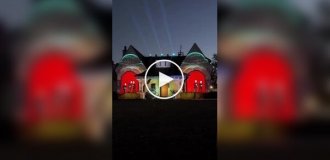This time we will not talk about the tombs of the pharaohs, not about piles of treasures hidden in them, but about the mummy of an ordinary priest of the god Amun. Its history and mystery are no less interesting than the stories of the royal mummies. 
In the photo on the left you see a part of an anthropoid sarcophagus with image of a noble Egyptian woman with a complex hairstyle of thick black hair, and on the right - a bald man. You won't believe it, but this is it. sarcophagus!
Neskaf-Amun (brought [as a gift] to Amon) - that was his name. A fairly common name among the priests of Amon. For example, one of them is A 15-year-old choirboy at the temple, whose mummy is still swaddled located in the Museum of Rouen (France).
For simplicity, we will call our priest a little easier - Nesamun.
He is not that rich, judging by the lack of expensive gold jewelry, although he was buried in a fine wooden sarcophagus, having provided all the necessary grave goods, in one of the rocky tombs in the area of Deir el-Bahri, where he was not disturbed for 29 centuries.
Alas, with the onset of the 19th century, everything changed.
Before that, only the graves of kings and nobles were plundered. persons where rich booty can be found. Tens, hundreds of thousands more modest no one was interested in ancient burials, but after the Egyptian campaign Napoleon's Europe fell ill with Egyptomania.
The theme of ancient Egypt suddenly became acutely fashionable and in demand. Everything was taken out of Egypt - any ancient things: from small figurines to multi-ton statues, even giant obelisks.
First just rich people, then companies and communities, and then then the European states themselves began to organize expeditions in search of Egyptian antiquities. Moreover, the "researchers" in these expeditions did not disdain to blow up ancient buildings with gunpowder, and then dynamite in search of coveted treasures.
Trade in antiquities flourished in Egypt itself and beyond its borders.
For example, there was such a fashionable fun in London - an invitation to a "party with a mummy". The highlight of such parties was unwinding the veils of ancient mummies - invited by candlelight watched by this process. The fate of the mummies themselves after such a show is few interested in - they were taken away for souvenirs, sold in parts for charlatan drugs for all diseases.
A huge and highly lucrative smuggling trade developed antiquities. This could not but affect the local residents, there were entire villages that lived for generations only by robbing the ancient burials. The scale of looting today is hard to even imagine.
This picture is quite typical of Egypt in the 19th century.
Mummy seller 1875, Egypt 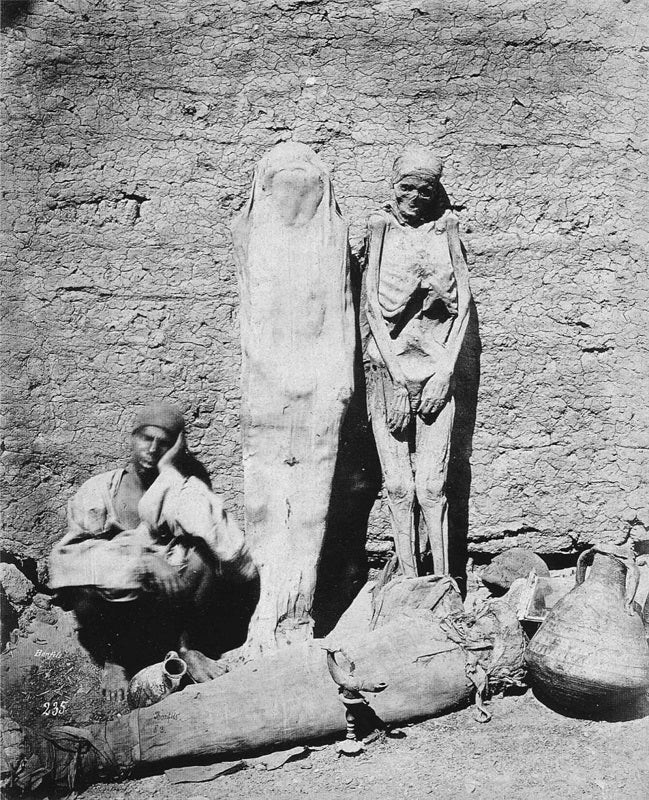
Photographer Felix Bonfils
In 1822, the sarcophagus with the mummy of Nesamun acquired the famous Italian antiquities dealer, antiquarian and smuggler Giuseppe Passalacqua.
According to him, the tomb was found near the temple Hatshepsut, and a few months later the find was sent by sea for sale in Trieste (Austria). There it was bought in 1823 by the Englishman William Bullock, from whose sarcophagus with a mummy, in turn, was bought by a banker from Leeds, John Blade and donated to the "Philosophical and Literary Society" his native cities.
In 1824, at the council of the society, the sarcophagus was opened and the mummy of Nesamun itself. All members of the society were present in the hall, including chief physician and surgeon of the city. Thanks to them we have a detailed story about this event.
This is the first ever attempt at a completely scientific study of an ancient Egyptian mummy.
In 1928, even the pamphlet "Study of the Egyptian Mummy" was published. (author William Osborne) on 60 sheets with a detailed and thorough description of the event with wonderfully executed drawings.
Here is one of them. 
Scan of a drawing from the book "Investigation of the Egyptian Mummy", by William Osborne
And now make yourself comfortable, we are transported to England in that gray dank evening in the autumn of 1824 and attend that event.
First, they carefully removed the cover of a wooden, skillfully painted sarcophagus. On it, in addition to the image of the face, hairstyles and jewelry, artist 12 scenes, on the lower part of the sarcophagus on the sides - another 30 scenes from the Book of the Dead.
Sarcophagus cover 
But in the next photo on the left, a close-up of the “face” of the sarcophagus full face. 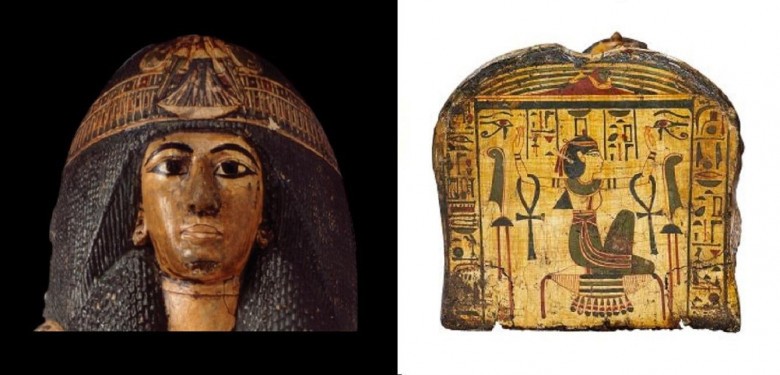
Taken from alchetron.com/Nesyamun
Pay attention to the hole on the "chin", there was inserted a short black bar that plays the role of a decorative beard. So Thus, the sarcophagus was conventionally turned from “female” into “male”. So-so modification, to be honest. But on the right in the photo - the image on the "heels" sarcophagus: the goddess Nephthys stretches out her hands with ankhs - symbols of eternal life and resurrection.
Why did they use a female sarcophagus? Most likely, the sarcophagus was bought in advance and it was not prepared specifically for Nesamun, such only the very wealthy could afford it. Alternatively, he may bought it ahead of time for his wife, but died earlier and was buried in German The inscriptions on the sarcophagus were made after the death of Nesamun with the mention of his name is clearly already on a specific order.
Under the lid was ... that's right - the second sarcophagus. Luxury, of course, not royal, but not everyone could afford two beautiful sarcophagus, because even one of these cost a lot. 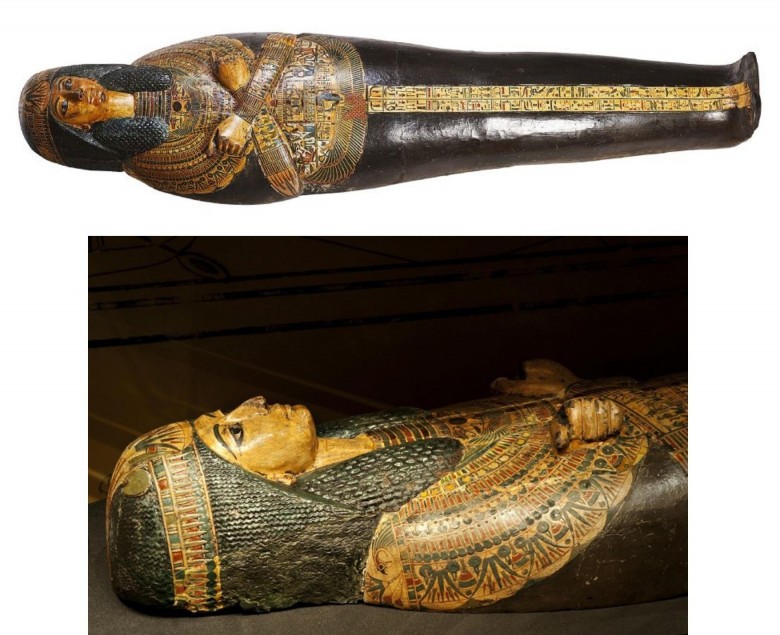
Cover of the inner sarcophagus of Nesamun
Then the mummy was taken out of the sarcophagus and the dark red leather belts that, like bandages, fastened the sheets. By the way, they didn't make it. to our time (lost), but their drawings with the image of hieroglyphs on them.
Photo of a mummy of the Ptolemaic period (Ptolemies - dynasty rulers of Egypt in the 4th-1st centuries BC) from the Louvre Museum, traces are already cut belts are noticeable, here it is worth paying attention to how much carefully and skillfully wrapped face. 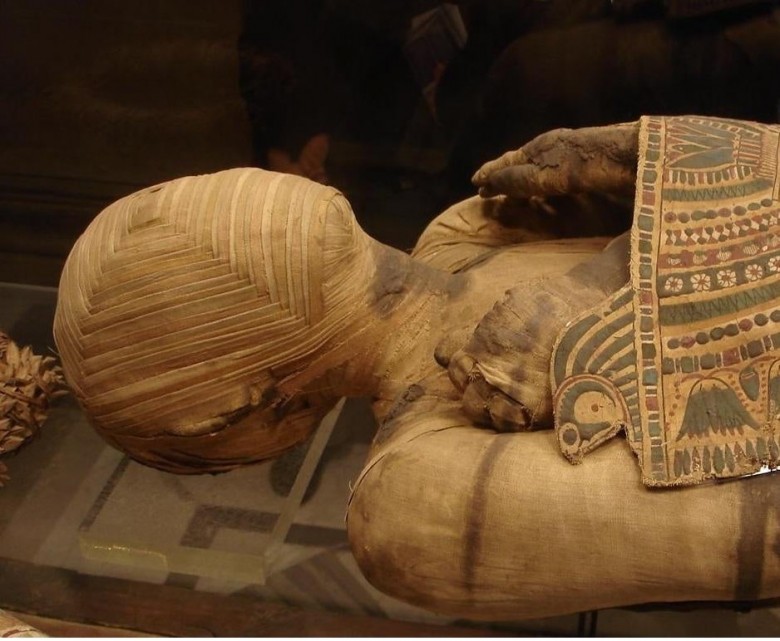
Taken from https://www.baixaki.com.br/papel-de-parede/43538-mumia-museu-du-louvre-paris.htm
Next, we move on to the most important thing - the removal of linen from the mummy.
They turned out to be as many as 40 layers. From above there was a very thin road beautifully crafted fabric, but below we used a simpler material and rougher.
Most likely, the embalmers thus saved, perhaps they took from relatives a complete set of the best fabrics, but wrapped them only on top, using mostly cheaper ones. At unwrapping the bandages, they also found several amulets and jewelry.
And finally, the last layers of the bandage are removed from the mummy's face ... but it is not visible!
The face and body are covered with a thick layer of powdery brown masses with a strong smell of cinnamon. It is made up of broken parts. plants and spices applied to the body by embalmers 3,000 years ago. AT in the past, it was a thick wet dough, which was evenly spread mummy before wrapping.
The powder is carefully cleaned off, and finally the face of Nesamun himself. 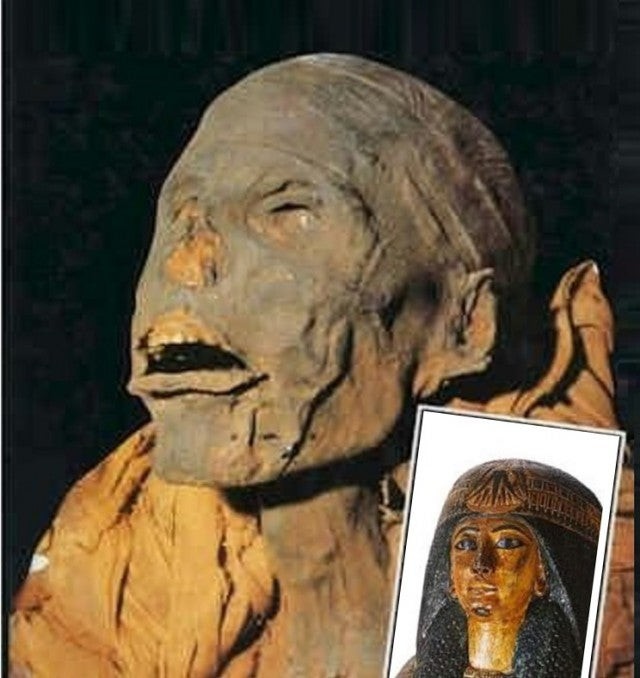
Used photo from The Mummy's Tale: The Scientific and Medical Investigation of Natsef-Amun, Priest in the Temple at Karnak Hardcover, 1993, by A. Rosalie David, Edmund Tapp.
Touching the skin of the mummy suddenly showed that she was not at all dry and brittle, but on the contrary - soft and as if oily. In fact what you see now is not quite what the members saw that evening "Philosophical and Literary Society of Leeds", his mummy nose lost more than a century later, but more on that later.
"At that moment, the mummy suddenly sighed and a soft groan was heard, which was clearly heard by some witnesses"
Not a single story can do without such "mystical" details. about mummies, so let's forgive this trifle to the author of the brochure. In fact she has nothing to “sigh” with - she has no lungs, trachea and other things, the embalmers removed all the insides, leaving only the heart, filling the body inside with the same fragrant mass with the smell of cinnamon. Brain removed through the right nostril, judging by the fact that it was thoroughly opened up.
The spectators were also struck by the very face of the mummy - its head thrown back and black tongue sticking out of the mouth nearly three-quarters of an inch, i.e. by 2 cm.
The doctor who performed the initial autopsy of the mummy suggested version of the violent death of Nesamun - strangulation or poisoning.
But we would be good if we trusted the opinion, even if highly respected pundits who lived almost two centuries ago.
To date, the mummy of Nesamun is the most studied ancient Egyptian mummy in the world.
It was comprehensively studied several times in the 1970s, 90s and 2000s. years, preferring non-invasive methods. It became possible due to the fact that access to the mummy is always open to scientists, which, to unfortunately, it is impossible to say, for example, about the mummies that are in charge of Supreme Council of Antiquities of Egypt. Also in the 2000s, again analyzed all the inscriptions on the sarcophagus, which revealed some nuances from life and works Nesamun.
However, in the twentieth century, the fate of the mummy was not so prosperous. as it may seem. She almost died during World War II. On the night of March 14-15, 40 Luftwaffe bombers dropped a deadly load of bombs on the city. Over 100 houses were destroyed almost a thousand were damaged, 65 people died. From great losses among the civilian population was saved only during the declared air strike. alarm, the population managed to go down to the bomb shelters.
One of the bombs hit the Leeds Museum directly. Two out of three died Egyptian mummies kept here. Nesamun was lucky, he "survived" if I may say so, but he was wounded - his nose was cut off with a fragment. It must be admitted that Nesamun himself, for obvious reasons, did not worried, but the museum workers suffered fear, removing it from the ruins museum. 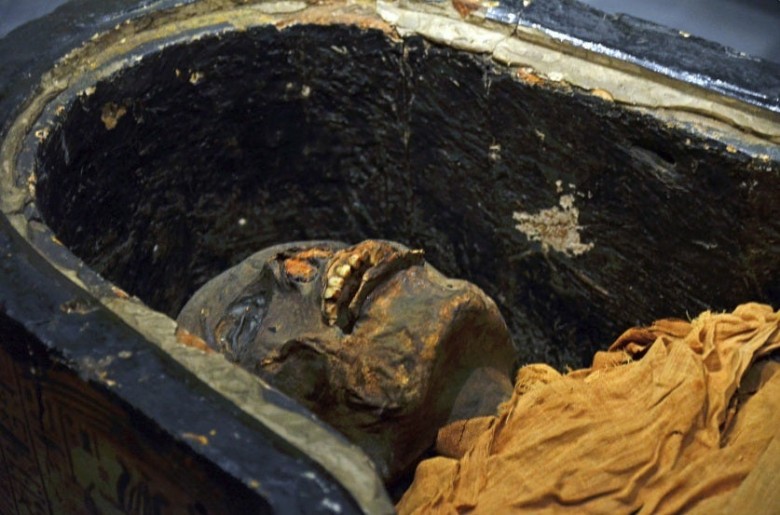
Nesamun and his "wounded" nose. Nesamun in his two sarcophagi. Due to its fragility, the inner sarcophagus has never been removed from the outer one. Photo from a museum in Leeds. Photographer Jon Farman
Nesamun (judging by the hieroglyphic inscriptions on his sarcophagi) was one of the priests in the temple complex of the god Amun in Karnak during reign of Ramses XI (1099-1069 BC). He turned out to be a priest occupying quite important positions in the temple of the god Montu at Karnak. The inscriptions testify that he is a priest of the temple of Montu, as well as a scribe who keeps a record of the cattle of the temple of the god Amun. Nesamun's official duties included keeping accounts and filling out cadastral records, reports and administrative documents.
He directly participated in the performance of rituals in the holy of holies of the temple in front of the statue of Amun and his life was ruled special rules, such as a daily double ritual washing and shaving.
Nesamun lived at a time when the high priest of Amun, Amenhotep the actual ruler of Thebes, came into conflict with Panehsi, the governor Nubia, and was killed by him.
Soon Panehsi himself declared himself the high priest of Amun. Himself Ramses XI had real power only in the north of the country. During the reign Panehsi in Thebes robbed many of the royal tombs in the Valley of the Kings. However soon the commander of Ramses Herihor expelled Panehsi from Thebes and declared himself high priest at Karnak.
Most likely, our priest died at Herihor. Availability leather belts (no longer in existence) with the cartouche of Ramses XI on the mummy Nesamuna does not necessarily mean his allegiance to this pharaoh. Most likely, these belts are only part of the gift of Ramses XI to the statue of god in the temple Montu. The connection with God undoubtedly seemed to Nesamun much more more important than the name of the ruling pharaoh.
Recent research included radiology, computer tomography, endoscopy, serology (immunological examination), histology (the study of the microscopic structure of tissues), dental expertise.
The study found that Nesamun suffered from filariasis - disease caused by parasitic worm larvae carried by mosquitoes. The worms migrate to the lymph nodes and cause swelling or fluid retention, leading to an unsightly swelling known as "elephantiasis".
Nesamun was also diagnosed with atherosclerosis - sclerotic plaques in blood vessels in the groin. This is a degenerative disease of the blood blood vessels caused by a diet rich in animal fat can lead to strokes, heart attacks and tissue necrosis followed by gangrene. Nerves connected to Nesamun's eyes were affected peripheral neuritis, a condition sometimes associated with diabetes or treatment with heavy metals. X-ray showed or degenerative arthritis of the neck and possibly the hip.
The condition of the bones indicates that Nesamun was not engaged in physical labor and died at the age of 35-45 years.
By the way, his teeth are full of seams. Usually Egyptologists associate this with wholemeal bread, in which sand and stone crumb. However, there are certain doubts about this, for the poor such a reason is quite possible, but for the needs of the rich, sift flour from heavy fractions are not so difficult.
So what could be the reason for this result? Excessive oral hygiene is possible, as, for example, ancient cosmetics could be detrimental to the skin of the face, remember at least such popular in Europe not so long ago lead white!.
Nesamun had broken remains of toothpicks between his teeth, and their the enamel is destroyed not only from above (chewing surface), but also from the sides. How option, the Egyptians could rinse their mouths with an acidic solution, disinfecting wounds and inflammations, while destroying tooth enamel.
What could be the cause of death of Nesamun, who died with his tongue hanging out?
There were originally two versions:
The first version was dropped immediately- the mummy was missing strangulation groove - a trace of a noose or loop, always remaining on a corpse. Also, the windpipe cartilage is intact, not broken. Of course, they could also strangle him with a wide scarf, simply by pinching the neck artery, however, this is extremely unlikely, since with this form there will be no suffocation and no tongue thrown out.
As for the second reason, the histological examination is not revealed no types of tumor in the tongue, it turned out to be quite normal sizes. However, none of the found ancient Egyptian mummies protruding tongue was not observed. There must be a reason for this!
And such a reason was found.
Immunologists suggested that Nesamun had an acute an allergic reaction to a bee or wasp sting that led him anaphylactic shock and a quick but painful death.
Unfortunately, it is impossible to give a 100% guarantee of the veracity of such a version, although it is very likely and today it is the most likely cause of death of Nesamun.
Reconstruction of the face of Nesamun, carried out in 1990 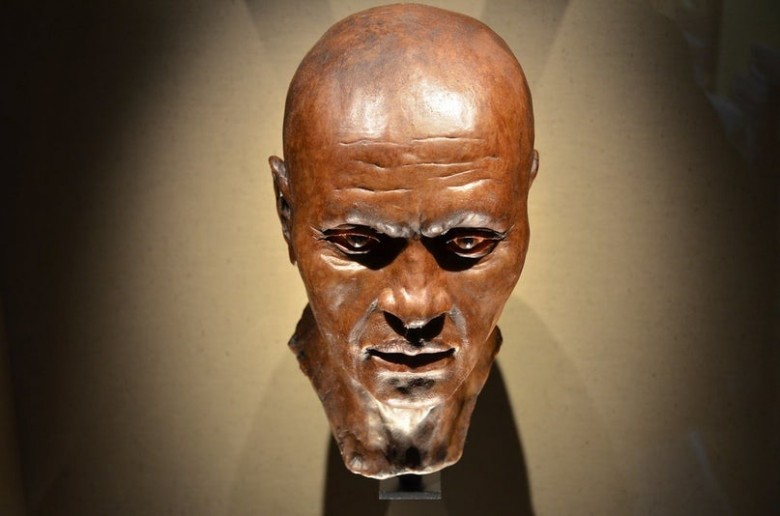
His facial features are thought to reflect a strong Nubian influence on the population of Upper Egypt.
Add your comment
You might be interested in:






